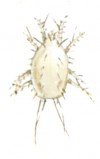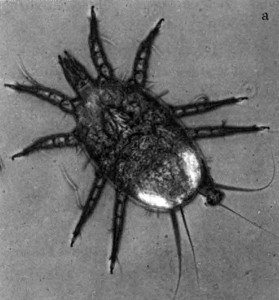
Latin: Carpoglyphus lactis.
Whitish, with an oval body, about 0.4 mm long. Its mouth parts are pointed, conical protrusions on the body. Each leg ends in a small claw, which sits on a patch of skin. Prune mites occur on substrates containing sugar by bacterial degradation of lactic acid, acetic acid, or succinic acid. It is typically found in cracks and folds in dried fruit, especially prunes and figs. It can also be found in honey bee hives. Its development takes place over a number of phases, as with the other mites. First, eggs that are attached to the substrate with a stem. Next, a six-legged larval phase, two or three 8-legged nymphal stages and finally adult males and females. Generation time is 9 days during optimal conditions at 25 ° C and 85% relative humidity.

A female mite can in 20 days lay 278 eggs and this explains how it is possible for a prune mite population to increase its number of individuals a hundred times within just 16 days. The prune mite itself does no real damage other than to discredit whatever it lives in as this gradually becomes disgusting and unsalable. Its presence is also an indication that the substrate may contain large amounts of the earlier mentioned bacteria and their metabolic products, which can also lead to significant changes in the taste and texture.
Prunes can be kept mite free when the water content is below 17% and when they are placed in a well ventilated a room where the humidity is below 50% RH and the temperature is at least 20 ° C. Prune mites do not reproduce at temperatures exceeding 35 ° C and multiplies slowest at 5 ° C. At 0 ° C reproduction is probably stopped.
A single package of dried fruit may be saved by a stay in the freezer for a few days, followed by thorough rinsing with warm water and it should be eaten immediately after this treatment. Jam cooking with a preservative may be the solution when it comes to large parties mite infested fruit. Prune mites in visible amounts are unlikely to be accepted by consumers.




